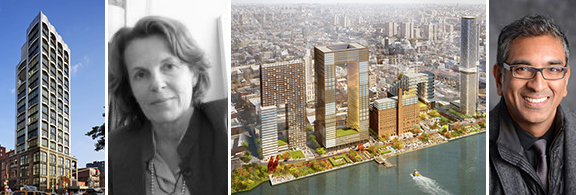When Vishaan Chakrabarti opened his new architecture firm last year, he made clear the kind of work the office would be willing to do. He also drew a line for the kind of clients the firm wouldn’t take on: Dictatorships and corporations with unfair labor practices.
During a discussion at the Center for Architecture on Tuesday, Chakrabarti said he prefers working for democracies. He cited architects and firms panned for their work abroad, including Snohetta, which is building a cultural center in Saudi Arabia and the late Zaha Hadid, who faced a wave of criticism over alleged mistreatment of migrant workers at the site of her Qatar stadium project. Some see prestige projects in monarchies as something to be avoided, he said, while others consider them necessary to bring progress to areas in desperate need of innovation. But he chided architects who work in countries simply to avoid “bureaucracy” and to “experiment” with little community intervention. The practice, he said, is akin to colonialism.
“I really don’t want to be part of it,” Chakrabarti said. “There’s a handshake, someone says ‘build me an icon,’ and you get a floating spaceship in the sand.”
What social obligations do architects bear? That question dominated the discussion, in which Chakrabarti was joined by architect Annabelle Selldorf as part of an event held by the American Institute of Architects.
The two architects are in very different places in their careers: Chakrabarti left his position as a principal at SHoP Architects late last year to form his own 12-person firm, the Partnership for Architecture and Urbanism. Selldorf heads her own 65-person firm, which she founded in 1988, with projects including 200 Eleventh Avenue and 10 Bond Street. Among other topics and a few Donald Trump jokes, the two spoke about the importance of architecture that interacts with the public.
“I go around town, and I see buildings that bend to the right or bend to the left, and they have a sort of clip holding them together, know what I mean? And I wonder what that’s good for,” Selldorf said. “It doesn’t satisfy me. It doesn’t do anything for people, not just the people that live there, but everybody else.” Though she didn’t mention the building by name, the description matches that of JDS Development Group’s American Copper Buildings at 626 First Avenue. The so-called ‘dancing towers’ are designed by, as it turns out, SHoP.
Selldorf then went into zen mode, emphasizing the need for buildings to serve a purpose higher than making use of “fabulous material.”
“As architects,” she said, “we need to understand where we came from and have an idea where we’re going to. There’s a fundamental responsibility that we have to accept and that we have to be accountable to. I think at the end of the day, it’s a consciousness.”
